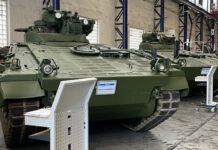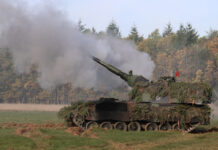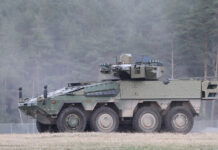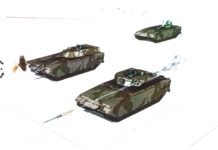With Russia’s war of aggression against Ukraine showing that fighting from, in and around the trenches is by no means a thing of the past, Romold, the Bundeswehr’s specialist for plastic cable ducts, presented a new plastic emplacement system at the most recent NATO Military Engineering Centre of Excellence’s Industry Day, held from 5 to 7 December 2023 in Ingolstadt, Germany.
Until now, emplacement systems have mainly been built from wood and sandbags, but the latest system from Romold, which is NATO certified (NC3A BOA 13118) and a recognised supplier of field camp construction in the German armed forces, offers advantages in terms of speed of construction and ease of handling.
“For a combat trench system made of wood, the pioneer troops have to carry out preparations such as felling and cutting trees to length, as well as configuration, such as with a mobile sawmill,” noted Sigurd Schönherr, project manager at Romold. “For tactical reasons the wood then has to be transported from disposition area A to deployment area B. There, the infantry begins to construct the emplacement system under the guidance and with the support of the sappers. Using a large number of tools and the specialised knowledge of the sappers, a 40 m trench is completed within 40 hours. If trenches of groups or platoons have to be connected during the course of the operation, the pioneers have to be called in again.”

The Romold plastic system is configured ‘just in time’ and can be delivered to the theatre of operations in a container. An infantry unit can complete a 40 m emplacement system, including four fighting positions, without tools within approximately 10 to 15 hours without the support of engineers, although, of course, the required earthworks must still be completed, most typically with the use of mechanical diggers. Extensions to the fighting trench can be completed by the infantry themselves in a quarter of the time without supporting engineers.
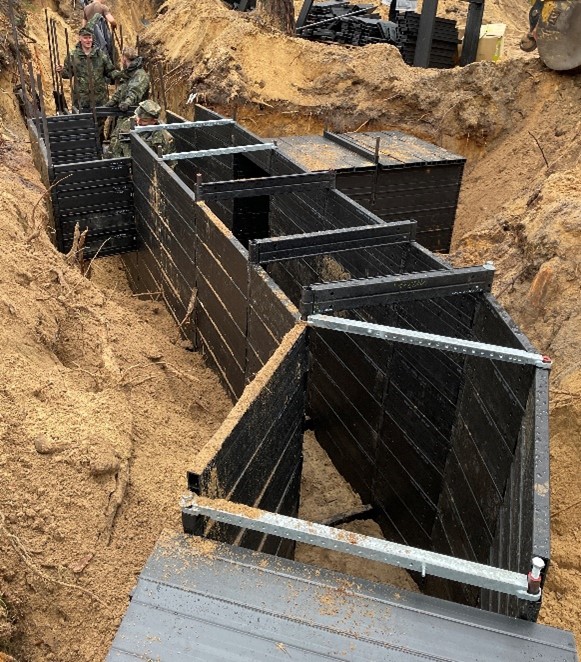
Romold’s plastic system thus relieves the engineers of a tasking and makes them available for other missions more quickly, while an infantry unit can organise its positions more independently and flexibly. Overall, the troops gain time during deployment, conserve their resources and increase their flexibility.
In addition, the system’s tool-free click & plug system – similar to the LEGO principle – offers further advantages because it can be handled by soldiers without any previous construction knowledge. Romold also points out that plastic weighs less than wood and, with the introduction of additives, has a lower fire load than wood. A plastic system can also be installed and removed and is therefore reusable.

The system
A first prototype of the Romold emplacement system was installed in May 2023 at the Lehnin military training area for and on behalf of the infantry school in Hammelburg. An infantry group built a 35-m-long trench system with four fighting positions and shelters. Since then, the system has been in use almost daily for training and exercising units and is also used for training Ukrainian units.
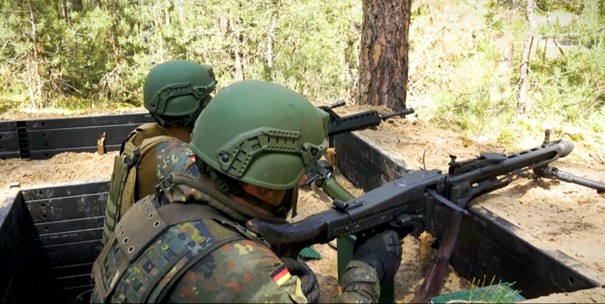
Although the prototype in Lehnin was delivered to the forest on Euro pallets, Romold also considers the use of containers to be an ideal alternative. A container would be both a means of transport and storage, thus protecting the system when not in use. The container would contain the entire system’s four component groups: support frames, wall profiles, roof profiles and floor grids.
Although the prototype lacks a group shelter or platoon/company command post, Romold believes corresponding capability requirements can be quickly and easily implemented and integrated into the system. The container could also be used for this purpose. The container size depends on the required running metres of the trench system, with Romold estimating that a 15-20 m3 container would be required for a 40 m trench.

According to Romold, the prototype trench in Lehnin has a kit weight of 88 kg per running metre, while the reinforced new rapid-construction kit presented at the NATO industry day weighs between 105 and 120 kg per metre. In comparison, a kit made of wood – in accordance with Bundeswehr regulation ZDv 3/760 Annex 4 and 7 – weighs 141 kg per linear metre.
The trench in Lehnin has a width of 80 cm and is approximately 80% covered, according to the specifications of the Hammelburg Infantry School. The newly designed kit is intended to be more in line with the current state of development and has a trench width of 90 cm with an 80% roof. It is also several times more stable than the prototype thanks to a new telescopic frame and modified wall and roof profiles, although this does result in a higher weight per running metre.
The prototype in Lehnin was erected by an infantry group of the guard battalion without prior knowledge in about 15 hours. According to Romold, the representatives of Pioneer Battalion 905 from Ingolstadt who were present estimated that it would take 40 hours to erect a comparable wooden emplacement system, which could only be erected by pioneers with specialised knowledge. The manufacturer estimates that an infantry group only needs around 10 hours to install the modified plastic kit.

Bundeswehr tests
The plastic profiles of the Romold emplacement system can be processed like wood in terms of drilling, sawing or nailing. Thanks to their click-and-plug principle, however, this is not actually necessary. The roof profiles of the modified system are clicked onto the side walls, thereby increasing the stability of the system. Depending on the version, the load-bearing capacity of the roof profiles allows them to be covered with 50 to 100 cm of soil and rock.
According to the manufacturer, polypropylene plastic components embedded in the soil do not rot (Romold specifies a service life of 50 to 100 years for all its plastic shafts). However, the system is not made entirely of polypropylene plastic. This is because all support frames are made of steel and form the static basis of the trench system. According to the manufacturer, production from considerably lighter glassfibre-reinforced plastic (GRP) as a pultrusion pipe is also possible, but is still being tested. As standard, these frames are designed for an internal trench width of 90 cm and consist of two vertically arranged tubes onto which the wall profiles are simply clicked. A usable length of 90 cm is planned as a standard wall profile with lengths of approximately 50 cm and 30 cm for length compensation and trench widening. The height of the wall profiles is 20 cm. The wall profiles are clipped horizontally onto the support frame from the outside, whereby the angle to the following unit can be selected flexibly and steplessly on each support frame.
A telescopic frame made of square tubes is inserted into the vertical tubes from above and below. This defines the trench width and additionally reinforces the vertical pipes against the earth pressure. The variable insertion depth of the telescopic frame enables height adjustment in the trench.
The floor grids supplied can be inserted to prevent slipping and ensure a dry stand.
The plastic used by the system, meanwhile, is recyclable; damaged or no longer required polypropylene components can be returned to the manufacturer, where the material can be cleaned, processed into granulate and reused.
The Romold system is currently still being tested by the German armed forces and is being further developed in parallel. At the NATO industry day, however, representatives of the British armed forces directly expressed their interest. The British Army has set up a project group that is working on the introduction of a new combat trench system. Here, too, the findings from Ukraine form the basis and Romold has been invited to participate.
The Austrian armed forces have also shown interest in the system and have already received documents for examination.





